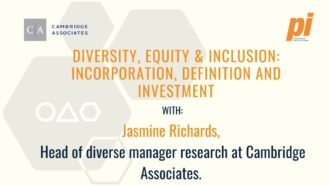A diverse asset management team is not typically a top priority when asset owners are selecting the firm they will entrust to invest their capital. While the importance of the investment world’s diversity narrative is growing, much work remains to be done.
A lack of role models has been a stumbling block. “There is a stark under representation in the asset management industry, in particular in investment teams,” says Justin Onuekwusi, a fund manager at Legal & General Investment Management (LGIM), who also founded EnCircle Mentoring, which mentors diverse asset managers.
Under representation is an issue also highlighted by Jasmine Richards, managing director and head of diverse manager research at Cambridge Associates. “I don’t think you can find another opportunity as large and under-funded as women and people of colour,” she says. “Globally, less than 2% of assets are invested with diverse fund managers and if you look at the number of investment products available, they represent approximately 10% of the universe.”
So diverse fund managers are not only under-represented, but also under-invested in. “Given the amount of research that has shown no trade-off in performance versus their white male counterparts, we see this as a tremendous investment opportunity for our portfolios,” Richards says.
Being authentic
In order to address the lack of investment in diverse talent, definitions will play a role. “What we’ve found is that the definition of a diverse organisation is unique to individual organisations and should be based on their individual goals,” Richards says. “However, when considering an investment, ultimately we are looking for authenticity.”
Cambridge Associates has surveyed its fund managers on the diversity of their ownership, management, investment decision-makers and teams since 2019. “Given the prevalence of data on the benefits of diversity in decision-making, transparency on demographics is table stakes [the minimum offering],” Richards says.
“When making investment decisions we are using that data as a jumping off point for a deeper discussion,” Richards adds. “We are investing in fund managers who not only consider the diversity of their investment teams but also diversity among their operating partners, developers, banking partners and the impact to the communities in their portfolios. All of that matters.”
In other words, not just asset managers, but also the wider investment chain should be considered when measuring diversity.
In this way, the process of involving more diverse managers is changing and evolving, albeit slowly, Onuekwusi says. “More and more stakeholders are putting more emphasis on understanding the people managing their client’s money and diversity is becoming a key part of that in terms of understanding and evaluating a fund manager team.”
Drivers of change
Where then, can real change come from? “There are three drivers,” Onuekwusi says. “One is the government, in terms of collecting data across the financial industry. Then there is the regulator. The discussion paper last year from the Financial Conduct Authority (FCA), Prudential Regulation Authority (PRA) and Bank of England (BoE) gave some indication that forthcoming guidance on diversity to be very powerful when it finally comes out.”
“And, of course, asset owners, who decide where money goes, have a real role to play,” he adds. “These three elements together form something of a trinity of the most important drivers for change.”
The triumvirate of FCA, PRA and the Bank of England seems keen to tackle the issue. “Diversity and inclusion can reduce groupthink, encourage debate and innovation, and thereby improve outcomes for consumers and across markets, supporting financial stability,” its report states.
A first step has been made. FTSE companies are now required to ensure that at least one third of their board members are female and, since the Parker Review, they are also obliged to include at least one director from an ethnic minority background. By the end of 2020, 89 of 100FTSE companies had complied with the new rule.
But there are those working to make blue chip companies do more in this area. For example, Share Action, a responsible investment charity, is targeting the financial sector to tackle the ethnic pay gap.
If such thinking is followed through it could be a game changer, especially in influencing and boosting diversity within asset management teams.
Standing together
And from the asset owner perspective, the push for more diverse asset management teams is being spearheaded by the Asset Owners Diversity Charter, which was created by the various pension schemes behind the Asset Owner Diversity Working Group, including Nest, Railpen, London CIV and Brunel Pension Partnership among others.
As part of this wider push, diversity questions form part of the selection process – meaning that fund managers wanting to work with these asset owners have to disclose information on, and demonstrate their commitment to, diversity and inclusion within their teams.
Signatories also commit to include diversity as part of their ongoing manager monitoring with a questionnaire provided to managers annually for completion. A key aim of the group is to create standardisation to improve disclosure.
This again could be an industry game changer in assessing diverse asset management teams and tracking how proactive particular asset managers are on the issue. The charter continues to grow, and is now supported by 23 signatories, who collectively manage more than £1.7trn worth of assets. Its financial clout is real and substantial.
“As asset owners we want to work with fund managers to encourage diversity at all levels and help build a fairer and more equitable investment industry that better represents our members,” says Diandra Soobiah, head of responsible investment at Nest. “Having a diverse range of skills, backgrounds and experience will lead to better investment decisions and financial outcomes for our members in the long term,” she adds.
Importantly, the charter has the government’s support with Guy Opperman a vociferous backer when he was pensions minister. It will be interesting to see if Laura Trott, his replacement, will continue to support this initiative.
The biggest barriers to investing with diverse managers comes from the investment process itself.
Jasmine Richards, Cambridge Associates
Adding value
And boosting the assets in diverse investment funds – and creating a larger set of opportunities for investors – starts with more investors recognising why diverse managers add value and developing an investment process that supports investing in diversity, says Meredith Jones, a consultant who was Aon’s former global head of ESG.
“Diversity can drive differentiated investment behaviour,” Jones says. “Women, for example, might make investment decisions that can help diversify portfolios and differentiate returns. Experience and background can also shape decision making, increasing diversification.”
This has also led to other recognised ways of addressing the issue of diversity within investment. “We have realised that investment industry participants need to take a more holistic view of diversity and support the development of diverse asset managers at all of the major inflection points on the fund launch pipeline,” Jones adds. “In a more supportive asset management ecosystem, more women-and minority-owned firms will be able to launch and scale.”
On this interpretation, this presents obvious challenges across the asset management world more broadly.
Investment process
But Richards also identifies other investment process hurdles in the diversity debate that have to be unravelled. “The biggest barriers to investing with diverse managers comes from the investment process itself,” she says.
“It is certainly important to have a diverse universe of investment managers to consider. However, without equitable adjustments to the process for investment-allocation decisions, investors will end up with the same result.
“The root of the problem isn’t the investments we are considering but the process we are using for evaluation,” Richards adds, giving simple advice for investors: “Re-think not only your investment universe but also your investment process.”
Cambridge Associates is following its own advice. “We are continually seeking to increase our investment in diverse managers by focusing on an equitable investment process. We are interrogating the profile of an ideal investment and the process through which we evaluate potential opportunities,” Richards says.
As an example, she says, when looking at a new opportunity, it is common to want a track record. “While well intended, understanding that less than 2% of private equity professionals are woman or people of colour, we can also see how this requirement can create structural barriers.
“To intentionally create equity in our investment process, we have creatively implemented methods where we can be expansive and inclusive in our track record evaluation. This has led to us being able to access high conviction investment ideas earlier than many of our peers.”
In addition to this, asset managers can shift the dial on this issue. “Most asset managers are starting to move in the right direction,” Onuekwusi says. “I do think if you are going to go out with a strong ESG message, then the S of ESG is clearly very important. I think it is difficult for asset managers to hold others to account when asset managers are not holding a mirror up to themselves.”
Setting limits
There is, a bit like the early days of ESG investing, often a misconception that focusing on diverse fund managers will limit potential returns because you are limiting your investment options.
“This is misguided,” Richards says. “Given the statistics in the industry, it is clear to see that women and people of colour have not historically been included equally. Rather than limiting the universe, we see a focus on diverse managers as an intentional effort to ensure we are expanding our investment options as broad as possible. This supports our ability to outperform.”
In fact, in terms of performance, the opposite appears to be true. A Boston Consulting Group study found that companies with more diverse management teams – including a broad range of backgrounds, ethnicities and gender – have 19% higher revenue due to innovation.
At companies where more than 20% of leading managers are women, share prices rose more during the previous decade than their peers, according to study by Credit Suisse.
So where is the destination and what does a good state of affairs look like on this multi-faced issue? “For me, this would be the asset management industry actually looking like the people it serves and the broader population,” says Onuekwusi. “And currently, we don’t have that.”.
So how long are we from getting there? “It will take at least a generation. But only if action is taken today to address the issue,” warns Onuekwusi.





Comments